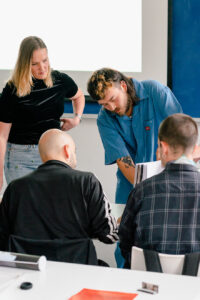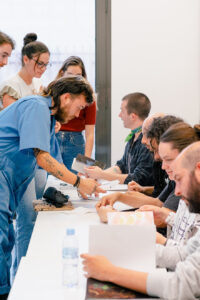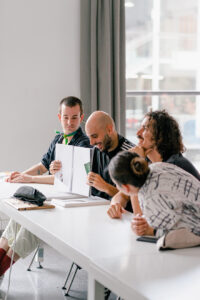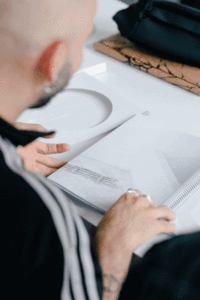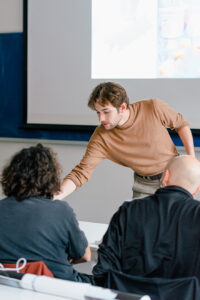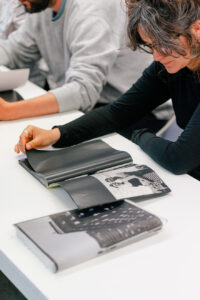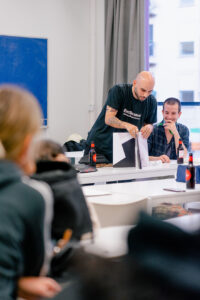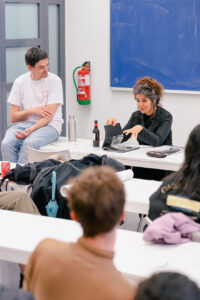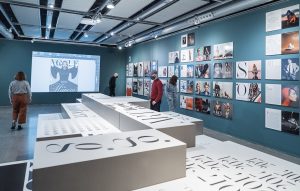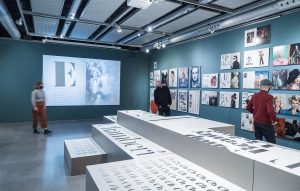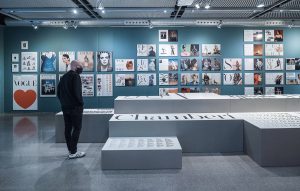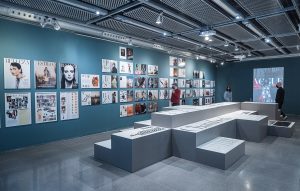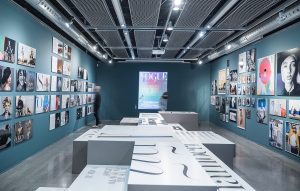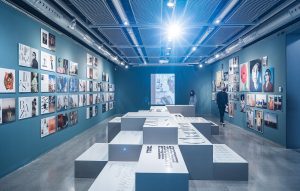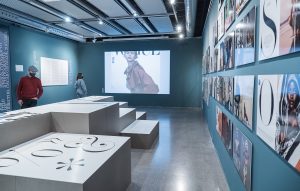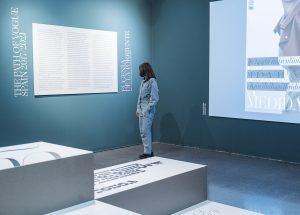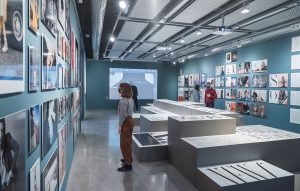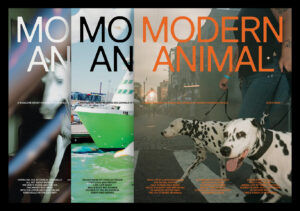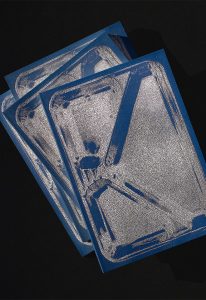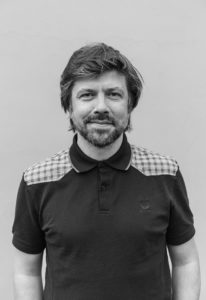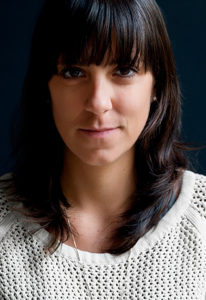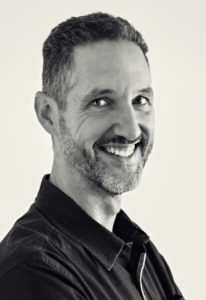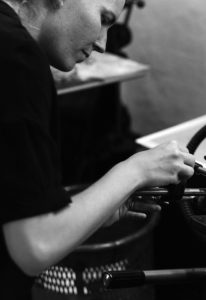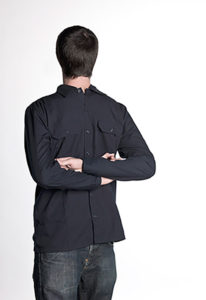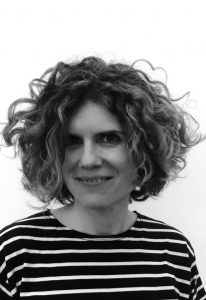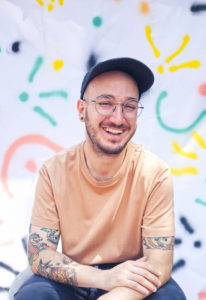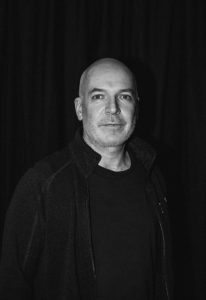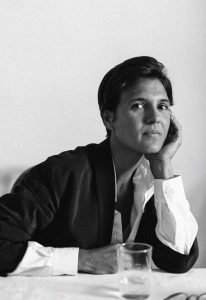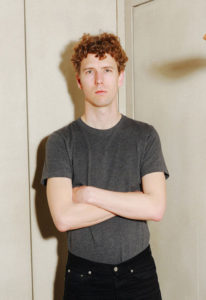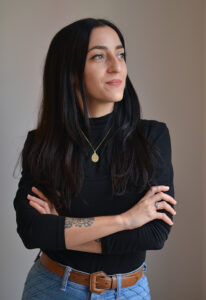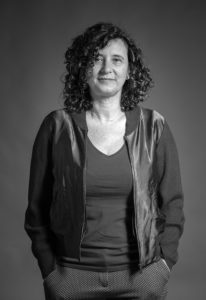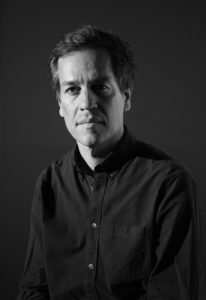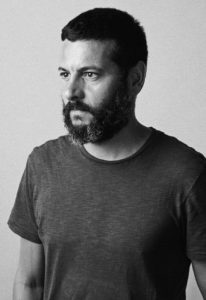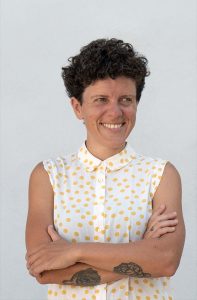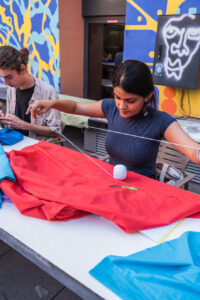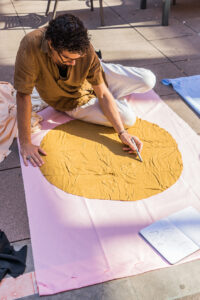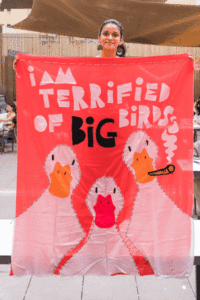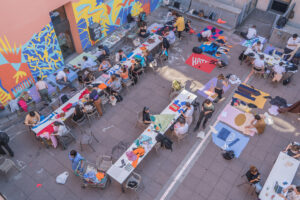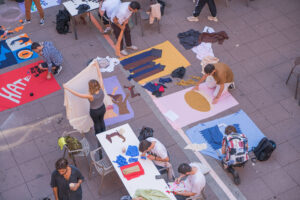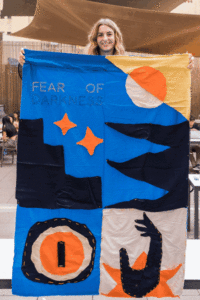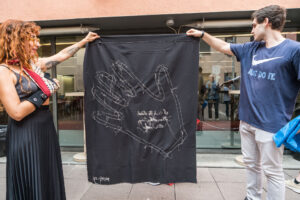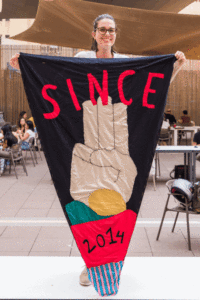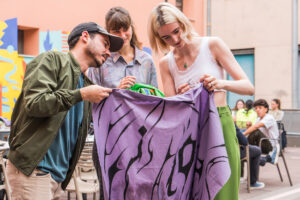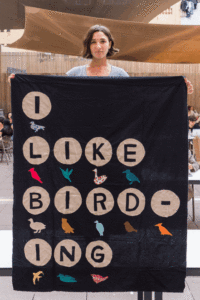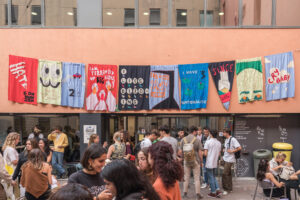MED → Master Editorial Design
How can graphic designers navigate between print, digital and content?
Explore the possibilities of editorial experiences beyond questions of format.
start date — September 2024
end date — July 2025
course lenght — 400 horas
ECTS — 60 credits
Languages — two editions
MED → in English
MDE → in Spanish
The workshops, showcases, case studies and lectures of both editions are in English.
schedule*
— Tuesday, Wednesday and Thursday
— from 5pm to 9.15pm
— workshops from Monday to Friday
*For academic reasons, sessions may be scheduled exceptionally outside these hours.
tuition fee
Academic year 24-25
12,000€
(plus 500€ in registration fees)
leading team
— Marc Panero, Director
— Thais Caballero, Coordinator
introduction
The field of editorial design has expanded drastically. The role of the designer has evolved from creator to producer. Designers have many processes to handle, and each new process becomes an opportunity.
The Master is open to curious, dynamic and proactive students who want to explore new relationships between design and content and delve into the symbiosis between print and digital.
Some people say print is dead, and the future will be strictly digital. The reality of it, however, is much more complex and exciting.
As opposed to furthering the disappearance of traditional formats, emerging practices harmonise with them and empower them, offering the user a more dynamic and transversal experience.
This situation offers great challenges and opportunities for designers who work in editorial design. The role of these professionals goes beyond the traditional; they have become content strategists and storytellers, relying on an in-depth knowledge of technology. Their goal is to forge a connection between content, context and formats.
At the MED you will gain new perspectives from international experts in the field of editorial design. Together, we will explore this new paradigm through projects, workshops and lectures. Not only will you discover responses to today’s challenges; you will learn how to approach the challenges of the future.
At the MDE we encourage research, creativity and imagination in the creation of editorial products.
Learn by doing: develop projects with support from professionals who are helping define what editorial design means today.
Today, designers must be incredibly versatile and open, with an understanding of how communication works beyond paper. Designers need to be able to turn a creative idea into multiple channels and assets.
The Master deals with the practice of editorial design from multiple perspectives and through different formats.
Editorial designers need to have the capacity to adapt to a changing industry and to play increasingly different roles.
our values
Learn by doing: develop projects with support from professionals who are helping define what editorial design means today.
Teamwork
Design today is practiced collectively, and we want this transformation to be reflected in our Master’s programme. Working smart and effectively to produce quality implies contrasting, collaborating and sharing. Therefore, during the Master, each student will form a team with one other student in the pursuit of a meaningful and fruitful collaboration.
Practice makes perfect
Theory is important; but the actual development of the graphic designer finishes in design practice. The Master’s programme is based on an eminently practical perspective: experience offers us most of the keys to design.
Close to the reality
This Master’s course is intended to orchestrate a fluid transition between the academic and professional worlds. We want students to develop the best parts of themselves, to fuel their motivation and generate a working environment that closely mirrors the professional world.
Students and professors: a collaboration
The programme faculty includes prestigious design professionals who play an active role in student development. Their experience and knowledge will serve as the source of constant advice in the search for solutions, to guide students in making their own decisions and developing their own perspectives.
featured projects
methodology
Today, designers must be incredibly versatile and open to understand how communication works beyond paper. Designers need to be able to turn a creative idea into multiple channels and assets
The practice of design needs decisive professionals with a mind of their own and a broad perspective on contemporary design. We want our Master’s programme to prepare students to meet those requirements through active experimentation and practical learning, with the support of quality professionals.
Students will work on three projects – a book, a magazine, and a digital platform – which they will develop in all aspects. Professors will collaborate in the process and encourage students to dig deeper, to go into detail without losing sight of the big picture, through a balanced combination of thinking, planning and action.
Beyond addressing technical aspects, the MED accompanies students in the pursuit of personal and professional development.
guest teachers and lecturers
workshops 23.24
Patrick Thomas
Matteo Moretti, Sheldon Studio
Serge Rompza, NodeBerlinOslo
Jon Uriarte, Photographer’s Gallery
Xavier Roca, Run Design
graphic.elisava lectures 23.24
Martin Lorenz, TwoPoints
Giliane Cachin
Samar Maakaroun, Pentagram
Julia Born
Julie Peeters
Anette Lenz
masters’ interdisciplinary workshops 23.24
Victor Guerithault, KiteLab
Christoph Brach, Raw Color
Sonja Stummerer & Martin Hablesreiter, Honey and Bunny
masters’ talks 23.24
Alice Rawsthorn
Yazmany Arboleda
Kaave Pour, SPACE10
Elric Petit & Augustin Scott de Martinville, BIG-GAME
Irma Boom
Eyal Weizman, Forensic Architecture
study plan
1
Master's projects
↓
Applying the dynamics of problem-solving, a necessary tool in the professional field, students will develop three projects throughout the course which will lead them to delve into the three fundamental areas of editorial design: a book, a magazine and a digital platform. Students will work with a different partner for each project to emphasise the importance of teamwork and complementary talents.
1.1
Book design
→
↓
In an increasingly digital world, what role does book design play? We will learn to conceptualise, develop and design meaningful publications, created only for the physical world, and executed in keeping with very high standards. We will push the limits of all aspects of editorial design – identity, typography, art direction, visual narrative, production, etc. – and we will learn to take full advantage of books as a medium for reading.
1.2
Design of periodicals
→
↓
Editorial design from the standpoint of structure and continuity. The goal is for students to understand the process that underlies the development of a periodical. We will analyse each step in the creative process: from the creation of an editorial concept to the development and editing of content, the art direction, the design process and the importance of the physical object.
1.3
Digital editorial platform
→
↓
We will answer two key questions: What is a digital editorial project today? What role does a designer play today? Society has changed dramatically and the publishing industry and the figure of the designer have been transformed. The designer can now be involved in all aspects of a project, from concept to form. Students will develop an idea as editors, create or commission content as art directors, and give it form and usability as designers.
1.4
Design Crit
→
↓
Critical sessions of informal discussion on the outstanding and perfectible points of the Master’s Projects with a guest professor and the director of the MED. The critique considers the work in relation to the previously defined goals and objectives, and explores why decisions are made and how effective (or not) they are in the context of the project.
In an increasingly digital world, what role does book design play? We will learn to conceptualise, develop and design meaningful publications, created only for the physical world, and executed in keeping with very high standards. We will push the limits of all aspects of editorial design – identity, typography, art direction, visual narrative, production, etc. – and we will learn to take full advantage of books as a medium for reading.
Editorial design from the standpoint of structure and continuity. The goal is for students to understand the process that underlies the development of a periodical. We will analyse each step in the creative process: from the creation of an editorial concept to the development and editing of content, the art direction, the design process and the importance of the physical object.
We will answer two key questions: What is a digital editorial project today? What role does a designer play today? Society has changed dramatically and the publishing industry and the figure of the designer have been transformed. The designer can now be involved in all aspects of a project, from concept to form. Students will develop an idea as editors, create or commission content as art directors, and give it form and usability as designers.
Critical sessions of informal discussion on the outstanding and perfectible points of the Master’s Projects with a guest professor and the director of the MED. The critique considers the work in relation to the previously defined goals and objectives, and explores why decisions are made and how effective (or not) they are in the context of the project.
2
Fundamentals
↓
The aim of editorial design is to make publications attractive, visually interesting and easy to read. A good editorial design is one that is consistent and clear with its purpose. Whenever typography and art direction are used effectively, they can evoke different feelings, and mastering these languages is key to editorial design.
2.1
Typography
→
↓
We strive for excellence in the choice and execution of typography in editorial design, both on paper and on screen. The aim is to develop our own criteria and typographic use, adapted to the conceptual, aesthetic, functional and technical characteristics of each editorial project. We want to consolidate the students’ knowledge of typography, in order to provide them with critical thinking and resolution skills.
2.2
Art Direction
→
↓
Learn the role of art direction in the world of magazines and books, often an underlying force in defining the identity and personality of a publication. This also includes the importance of social media and digital platforms in support of printed matter. Develop research skills and a working knowledge of the different actors involved in the production of editorial content..
We strive for excellence in the choice and execution of typography in editorial design, both on paper and on screen. The aim is to develop our own criteria and typographic use, adapted to the conceptual, aesthetic, functional and technical characteristics of each editorial project. We want to consolidate the students’ knowledge of typography, in order to provide them with critical thinking and resolution skills.
Learn the role of art direction in the world of magazines and books, often an underlying force in defining the identity and personality of a publication. This also includes the importance of social media and digital platforms in support of printed matter. Develop research skills and a working knowledge of the different actors involved in the production of editorial content..
3
Craft and trade
↓
Provide students with an essential set of skills for the editorial designer and, at the same time, allow them to improve their three Master’s Projects from different points of view, whether it be quality copywriting, defining an aspect of production or preparing the final arts.
3.1
Process Design and Facilitation
→
↓
The times when a designer could work exclusively alone without the need to collaborate with anyone else are over. Today’s industry requires us to work with clients, users and other profiles to complete our tasks brilliantly.
Such collaborations do not happen by magic. We must design our co-creation processes and establish frameworks that help us work more smoothly and efficiently.
3.2
Graphic Arts
→
↓
Graphic production is present throughout the whole design process and is an inextricable part of it. Colour management, printing techniques, paper, binding, finishes, etc. Mastery and experimentation in all of them provides the designer with great added value and allows him/her to extract the maximum from his/her creative process.
3.3
Creative Writing
→
↓
Designers also need to be able to assess the quality, intention and tone of a text. Drawing on classic journalistic and narrative tools, we will discover the creative potential of text. We will analyse practical examples by designers who have dealt with texts they do not understand, and we will look at the solutions they have applied. Finally, we will explore basic textual structures and their translation into design, so that form and content go hand in hand.
3.4
Creative production
→
↓
The layout of books and magazines is a fun and stimulating creative process, but at the same time highly complex and multidisciplinary, which requires an advanced command of concepts, techniques and tools related to graphic design, typography, colour reproduction and printing systems. In this course we will teach you the methodology and tricks needed to produce technically flawless files quickly and efficiently.
The times when a designer could work exclusively alone without the need to collaborate with anyone else are over. Today’s industry requires us to work with clients, users and other profiles to complete our tasks brilliantly.
Such collaborations do not happen by magic. We must design our co-creation processes and establish frameworks that help us work more smoothly and efficiently.
Graphic production is present throughout the whole design process and is an inextricable part of it. Colour management, printing techniques, paper, binding, finishes, etc. Mastery and experimentation in all of them provides the designer with great added value and allows him/her to extract the maximum from his/her creative process.
Designers also need to be able to assess the quality, intention and tone of a text. Drawing on classic journalistic and narrative tools, we will discover the creative potential of text. We will analyse practical examples by designers who have dealt with texts they do not understand, and we will look at the solutions they have applied. Finally, we will explore basic textual structures and their translation into design, so that form and content go hand in hand.
The layout of books and magazines is a fun and stimulating creative process, but at the same time highly complex and multidisciplinary, which requires an advanced command of concepts, techniques and tools related to graphic design, typography, colour reproduction and printing systems. In this course we will teach you the methodology and tricks needed to produce technically flawless files quickly and efficiently.
4
Workshops
↓
Workshops help complement and deepen knowledge of other competences and disciplines of editorial design. They take the form of meetings with specialists and recognised professionals. They are usually scheduled from Monday to Friday.
4.1
Experience
→
↓
Research, experimentation and observation are essential to promoting talent. To that end, we offer students the opportunity to spend a week sharing with and learning from a professional from the international design scene who has developed a distinctive and recognisable visual language.
4.2
Editorial Artifacts
→
↓
4.3
Photobook
→
↓
We delve into the world of the photobook, drawing on its foundations and development. Working with an author, students will discover the particularities of the process of creation, learning how to develop narrative, rhythm and sequence in a photobook.
4.4
Grad Show
→
↓
The final workshop of the Master’s course involves a public exhibition of the work done during the course, in a variety of formats. In this case, students are tasked with developing an actual, complete exhibition and editorial project: it is an intense process that takes place with a very tight deadline and results in the Degree Show.
Research, experimentation and observation are essential to promoting talent. To that end, we offer students the opportunity to spend a week sharing with and learning from a professional from the international design scene who has developed a distinctive and recognisable visual language.
We delve into the world of the photobook, drawing on its foundations and development. Working with an author, students will discover the particularities of the process of creation, learning how to develop narrative, rhythm and sequence in a photobook.
The final workshop of the Master’s course involves a public exhibition of the work done during the course, in a variety of formats. In this case, students are tasked with developing an actual, complete exhibition and editorial project: it is an intense process that takes place with a very tight deadline and results in the Degree Show.
5
Events
↓
To listen is to learn. Specially, when professionals, emerging or consolidated, share their life experience through their professional career. Inspiration has to find you working, but also listening.
5.1
International lectures
→
↓
We invite prestigious international figures to give lectures that allow students to learn first-hand about experiences, projects and case studies in different fields of graphic design.
5.2
Masters’ Talks
→
↓
We organise talks with outstanding creators from different fields that allow us to share experiences, observe design phenomena, obtain new points of view, reflections and references that enrich our interdisciplinary perspective on design.
We invite prestigious international figures to give lectures that allow students to learn first-hand about experiences, projects and case studies in different fields of graphic design.
We organise talks with outstanding creators from different fields that allow us to share experiences, observe design phenomena, obtain new points of view, reflections and references that enrich our interdisciplinary perspective on design.
Due to our interest to constantly improve our programme and the professional realities of our teachers, we keep the right to make changes in the content and the professors of the course.
experience
“The MED is an opportunity to learn not only from supportive teachers but highly experienced designers and an invitation to get acquainted with Barcelona’s creative scene. It was truly inspiring to dwell in this rich and stimulating habitat” Joana Teixeira, MED 20
Expand your perspective
The Master Editorial Design is intended to be the beginning of something new, not an inevitable step in your career. We want this course to prepare you to find your own professional path. As such, we will encourage you to foster your independence and nurture your talent as you explore the different disciplines of editorial design.
Discover your potential
Learn to connect different ideas and perspectives to expand the possibilities in your future. We offer you the tools and the experience you need to design, develop strategies, generate content, or manage the creative process.
Build an excellent portfolio
The projects that you will complete during the course will give you the knowledge and skills necessary to create an excellent portfolio – the key to making the transition into the professional world.
Have a unique experience
The combination of projects, workshops, lectures and mentoring make this Master a great opportunity to build your knowledge and broaden your experience.
Live in a city awash with design
Barcelona is awash with design, culture, gastronomy and events of all kinds; it’s the ideal setting for learning and fun. Barcelona is inspiring, and your stay is sure to be an unforgettable experience.
Be part of a multicultural and enriching environment
Our students come from all over the world and create a vibrant cultural atmosphere where the exchange of ideas, points of view and cultures takes place in a natural way.
practical info
Who is this programme for?
Graphic Design graduates and professional practitioners with experience.
Exceptionally we will admit Communication, Fine Arts and Advertising graduates with a suitable portfolio.
You must have advanced knowledge on Graphic Design software.
Editions and languages
Two editions of the Master’s course are held each academic year, one in Spanish (MDE Máster Diseño Editorial) and one in English (Master Editorial Design).
Number of students
Each year a maximum of 20 students are selected.
The candidates will be selected as inscriptions come through till the quota is filled.
Degree
Master’s Degree in Editorial Design, degree awarded by Universitat de Vic – Universitat Central de Catalunya (UVic-UCC) and ELISAVA Barcelona School of Design and Engineering
